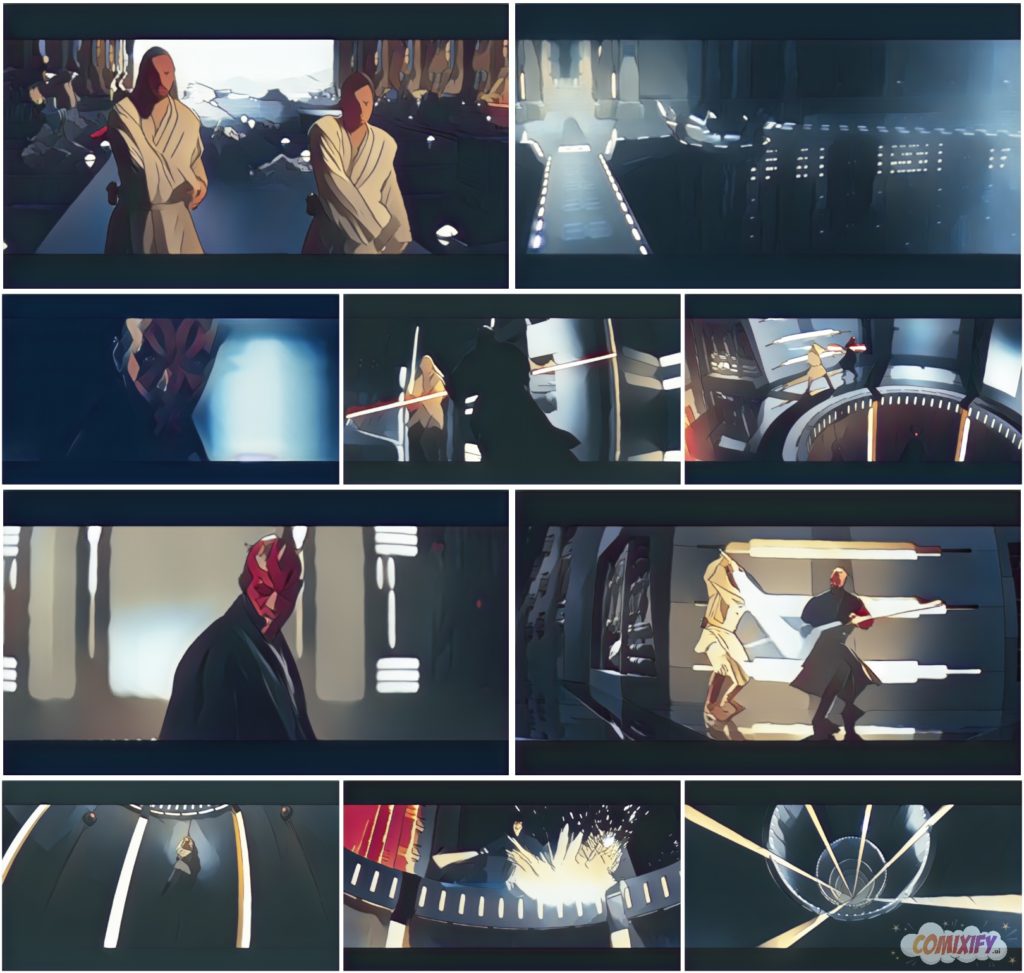About the client
Comixify is a product of scientific research, machine learning, and fascination for comic strips. It started out as a student project born at Warsaw University of Technology. Today, it’s a business platform offering tools designed to automatically edit videos and images using machine learning models.
The startup initially offered a service of conversion of videos into comic strip-styled graphics – ML algorithms would select the best frames from a video, modify the stroke, and apply effects onto a board, where the user could add balloons with their own textual content.

At present, Comixify is largely a VFX (visual effects) platform. It offers video post-production and real-time editing tools, including:
- Super Slow Motion,
- Super Resolution,
- Style Transfer,
- Automated Rotoscoping,
- Inpainting.
Since the very beginning, the platform has aspired to go global, establishing partnerships with large enterprises – Comixify’s technology has been used by e.g. BBC, PKN ORLEN or Wydawnictwo Naukowe PWN. The plan for 2021 involves making the same VFX tools available to non-business users within the framework of a SaaS model. As told by Bolesław Michalski, the CMO & COO of Comixify, the free feature of conversion of videos into static comic strips is still widely popular among students, teachers, and… cat lovers.
The challenge
In 2019, when the platform was launched, its creators faced a complex challenge. On the one hand, they had great ambition. On the other hand – like most startups – they had limited human and financial resources.
They planned a large-scale expansion so it was crucial to maintain global accessibility and efficiency. At the same time, to lower the barrier to entry for new users, they didn’t want to go for a desktop app in order not to overload the end-user’s hardware with local computing. Training machine learning models as well as the automatic video processing using the developed technology both require loads of computing power – including GPU and TPU. The long-run perspective for the VFX platform for business was to sell services that would be run within the user’s own infrastructure. That’s why Comixify was looking for a solution suitable not only to its own needs but also to the needs of its future clients and partners.
Cloud seemed to be the perfect choice. Especially given the fact that the model of payment for cloud services makes it possible to split the high costs of investment in computing power into “installments”.
The platform’s creators tested different cloud-based solutions, looking for the best price-to-performance ratio. Since four out of the five members of the team are ‘technical’ persons, who engage their time and knowledge into the development of Comixify (the startup doesn’t hire subcontractors), they also focused on the solution’s configuration speed and user-friendliness.
The solution
The choice was made to go for Google Cloud Platform as a cloud offering a wide range of virtual machines, optimal pricing, and a user-friendly interface.
We knew we’d have to make use of, for instance, GPUs, which would mean a really huge investment. We based our choice largely on the cloud services available in 2019. Google Cloud’s offering came at the best price, and we could spread the costs of computing power over time and optimize them. This way, taking each step on the path of development in a conscious fashion, we’ve come to where we’re at now.
As Bolesław says, Google Cloud Platform is now present in virtually every part of the startup. The team uses Google Cloud services to e.g. host the comixify.ai web service, to train machine learning models, to serve VFX tools, and to implement new features.
The app as a whole has the form of a microservice architecture, with a big part in keeping the high rate and stability of development played by Google Kubernetes Engine. The founders also take advantage of the broad range of options to configure machines using Compute Engine (including an instance with GPU or Preemptible VMs), launched to train ML models. Paweł Andruszkiewicz, Comixify’s co-founder with an extensive technological background, speaks also of one of the top services, Cloud Load Balancing, which makes it possible to ‘unburden’ creators and take over the control over traffic management at little cost.
Google Kubernetes Engine provides us with a stable and familiar environment. It takes over many duties involved in cluster management and lets us focus on the development of the app. Apart from making extensive use of Compute Engine and Cloud CDN services, we’re also keen users of Cloud Storage, Cloud SQL, Cloud Pub/Sub, and the Operations suite (Stackdriver).
The creators of the platform, looking for ways to optimize costs and maintain performance at the same level, decided to work with a local Google Cloud Partner. They signed the agreement with FOTC with a view to improve not only their own situation but also the situation of their future clients, recommending them launching their VFX platform in Google Cloud with full confidence.
We had talks with other Google Cloud Partners before, but only FOTC turned out to be so… persistent in their efforts to understand our needs. Me myself as the Operations Director and our Technical Director alike got on the same wavelength with Fly Guys in different areas of importance to us. The fact that the three of us found a common ground where we could discuss the problems we faced and the possible solutions to them was the reason we decided to work together.
Results
As Bolesław says, GCP was the best choice to start with. The team didn’t have to incur initial costs to purchase its own machines, and an investment in a cloud-based solution translates into time savings – when building a startup alone, the founders feel that they invest their time and energy into development and not into the management of physical infrastructure. Gaining access to loads of computing powers is a matter of a few minutes, and once the job is done, the instance can be shut down, which translates into a flexible budget.
The fact that we don’t spend our time on maintaining our own data center comes at a slightly higher price for the computing power from Google’s data center. But we consider it smart outsourcing in the long run because we can use this time and the available resources to develop our product, which is of much greater value to us.
The partnership with FOTC has made it possible to make more savings in the area of infrastructure. In the case of an up-and-coming startup, whose majority of shares remains with its founders, being able to reduce its costs by even a bit over ten percent is a big thing. Especially since one of Comixify’s pillars is computing power – which is a quite expensive asset.
The founders are aware that the optimization of their own costs will make it also possible to optimize the infrastructural costs incurred by Comixify’s clients and partners. By selling VFX platform tools for business, they can recommend Google Cloud Platform services to others and advice on how to reduce the costs of cloud infrastructure without compromising on performance.

